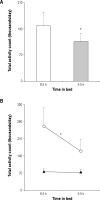Sleep restriction decreases the physical activity of adults at risk for type 2 diabetes
- PMID: 22754044
- PMCID: PMC3369233
- DOI: 10.5665/sleep.1964
Sleep restriction decreases the physical activity of adults at risk for type 2 diabetes
Abstract
Study objective: To test the hypothesis that recurrent sleep curtailment will result in decreased physical activity in adults at risk for type 2 diabetes.
Design: Two-condition 2-period randomized crossover study.
Setting: University General Clinical Research Center.
Participants: Eighteen healthy patients with parental history of type 2 diabetes (9 females and 9 males, age 27 yr [standard deviation 3], body mass index 23.7 [2.3] kg/m²).
Interventions: Two week-long inpatient sessions with 8.5 or 5.5-hr nighttime sleep opportunity. Participants who exercised regularly (39%) could follow their usual exercise routines during both sessions.
Measurements and results: Sleep and total body movement were measured by wrist actigraphy and waist accelerometry. Subjective mood and vigor was assessed using visual analog scales. The main outcome was the comparison of total activity counts between sleep conditions. Ancillary endpoints included changes in sedentary, light, and moderate plus vigorous activity, and their association with changes in mood and vigor. Daily sleep was reduced by 2.3 hr (P < 0.001) and total activity counts were 31% lower (P = 0.020) during the 5.5-hr time-in-bed condition. This was accompanied by a 24% reduction in moderate-plus-vigorous activity time (P = 0.005) and more sedentary behavior (+21 min/day; P = 0.020). The decrease in daily activity during the 5.5-hr time-in-bed condition was seen mostly in participants who exercised regularly (-39 versus -4% in exercisers versus nonexercisers; P = 0.027). Sleep loss-related declines in physical activity correlated strongly with declines in subjective vigor (R = 0.90; P < 0.001).
Conclusions: Experimental sleep restriction results in decreased amount and intensity of physical activity in adults at risk for type 2 diabetes.
Keywords: Physical activity; familial risk of diabetes; regular exercise; sedentary behavior; sleep restriction.
Figures


Similar articles
-
Reduced physical activity in adults at risk for type 2 diabetes who curtail their sleep.Obesity (Silver Spring). 2012 Feb;20(2):278-84. doi: 10.1038/oby.2011.306. Epub 2011 Oct 13. Obesity (Silver Spring). 2012. PMID: 21996665 Free PMC article.
-
Effect of sleep curtailment on dietary behavior and physical activity: A randomized crossover trial.Physiol Behav. 2018 Feb 1;184:60-67. doi: 10.1016/j.physbeh.2017.11.008. Epub 2017 Nov 9. Physiol Behav. 2018. PMID: 29129611 Clinical Trial.
-
Changes in insulin secretion and action in adults with familial risk for type 2 diabetes who curtail their sleep.Diabetes Care. 2011 Oct;34(10):2259-64. doi: 10.2337/dc11-0777. Epub 2011 Aug 11. Diabetes Care. 2011. PMID: 21836106 Free PMC article.
-
Inducing more sleep on school nights reduces sedentary behavior without affecting physical activity in short-sleeping adolescents.Sleep Med. 2018 Jul;47:7-10. doi: 10.1016/j.sleep.2018.03.007. Epub 2018 Mar 29. Sleep Med. 2018. PMID: 29880148 Clinical Trial.
-
Sedentary behavior as a mediator of type 2 diabetes.Med Sport Sci. 2014;60:11-26. doi: 10.1159/000357332. Epub 2014 Sep 9. Med Sport Sci. 2014. PMID: 25226797 Free PMC article. Review.
Cited by
-
Sleep and obesity: the mediating role of health behaviors among African Americans.Sleep Health. 2019 Apr;5(2):193-200. doi: 10.1016/j.sleh.2018.12.005. Epub 2019 Jan 17. Sleep Health. 2019. PMID: 30928121 Free PMC article.
-
Insomnia is associated with an increased risk of type 2 diabetes in the clinical setting.BMJ Open Diabetes Res Care. 2018 Dec 26;6(1):e000604. doi: 10.1136/bmjdrc-2018-000604. eCollection 2018. BMJ Open Diabetes Res Care. 2018. PMID: 30687505 Free PMC article.
-
The effect of sleep deprivation and restriction on mood, emotion, and emotion regulation: three meta-analyses in one.Sleep. 2021 Jun 11;44(6):zsaa289. doi: 10.1093/sleep/zsaa289. Sleep. 2021. PMID: 33367799 Free PMC article.
-
Codeine plus acetaminophen improve sleep quality, daily activity level, and food intake in the early postoperative period after photorefractive keratectomy: a secondary analysis.Arq Bras Oftalmol. 2021 Jan-Feb;84(1):45-50. doi: 10.5935/0004-2749.20210008. Arq Bras Oftalmol. 2021. PMID: 33470341 Free PMC article. Clinical Trial.
-
Obstructive Sleep Apnoea, Other Sleep Parameters and Diabetic Retinopathy.Curr Diab Rep. 2021 Dec 13;21(12):58. doi: 10.1007/s11892-021-01425-0. Curr Diab Rep. 2021. PMID: 34902078 Review.
References
-
- Sargeant LA, Wareham NJ, Khaw KT. Family history of diabetes identifies a group at increased risk for the metabolic consequences of obesity and physical inactivity in EPIC-Norfolk: a population-based study. The European Prospective Investigation into Cancer. Int J Obes. 2000;24:1333–9. - PubMed
-
- Laaksonen DE, Lindstrom J, Lakka TA, et al. Physical activity in the prevention of type 2 diabetes: the Finnish diabetes prevention study. Diabetes. 2005;54:158–65. - PubMed
-
- Samaras K, Kelly PJ, Chiano MN, Spector TD, Campbell LV. Genetic and environmental influences on total-body and central abdominal fat: the effect of physical activity in female twins. Ann Intern Med. 1999;130:873–82. - PubMed
Publication types
MeSH terms
Grants and funding
LinkOut - more resources
Full Text Sources
Medical

